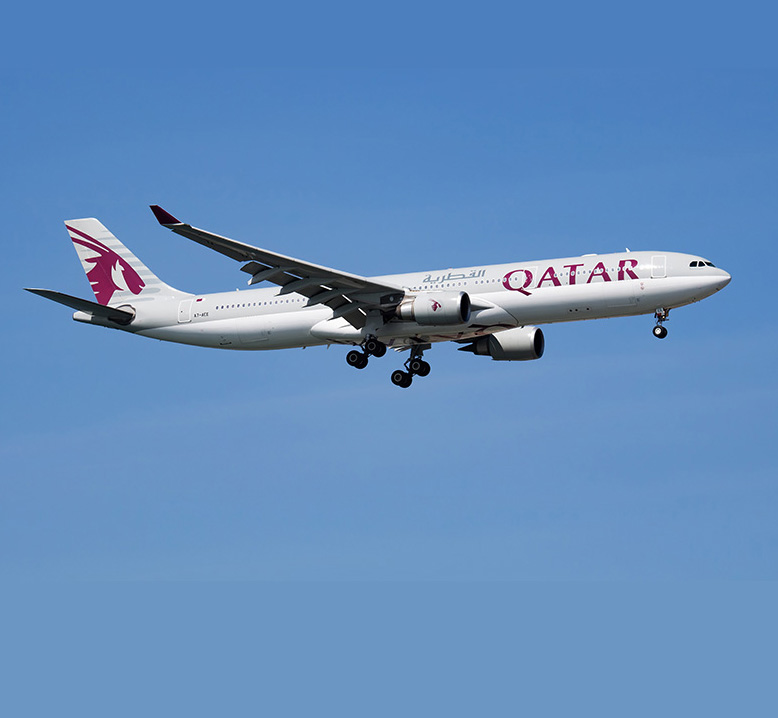Qatar Airways’ Ambitious Plans for a Major Wide-Body Jet Order Amid a Thriving Aviation Market


In a bold move signaling its confidence in the resurgence of global air travel, Qatar Airways has confirmed that it is in advanced discussions with leading aircraft manufacturers, Airbus and Boeing, for a significant wide-body jet order. According to recent reports, the airline could announce an order for up to 200 jets during the prestigious Farnborough Air Show in July. This announcement comes at a time when the aviation industry is experiencing a remarkable recovery from the pandemic, with expectations for record-breaking profits and passenger numbers in 2024.
The International Air Transport Association (IATA) forecasts a prosperous year for global airlines, projecting that nearly 5 billion passengers will take to the skies in 2024. This surge in passenger numbers is expected to drive airline revenues to an impressive $1 trillion, marking a 10% increase from the previous year. This optimistic outlook reflects the pent-up demand for air travel, which has been building up over the past few years of travel restrictions and uncertainties.
The surge in passenger numbers can be attributed to several factors, including the easing of travel restrictions, the widespread distribution of vaccines, and the growing consumer confidence in air travel safety measures. This resurgence is not just a testament to the resilience of the aviation industry but also a reflection of the vital role that air travel plays in connecting people and economies worldwide.
The projected revenue boom to $1 trillion underscores the significant economic impact of the aviation industry. This growth is not just limited to ticket sales but also encompasses ancillary revenues from services such as baggage fees, in-flight purchases, and premium seating options. Airlines are capitalizing on this trend by enhancing their service offerings and implementing dynamic pricing strategies to maximize revenue.
The IATA’s projections indicate that airlines are on track to achieve a record $30.5 billion profit this year, a substantial increase from the $27.4 billion profit recorded in 2023. This remarkable recovery is even more significant when considering the $140 billion loss suffered by the industry during the pandemic year of 2020.
North America continues to lead the profitability charts with an expected $14.9 billion profit, driven by strong domestic travel demand and robust economic conditions. The region’s airlines have benefited from their swift adaptation to changing market conditions and effective cost management strategies.
Asia, on the other hand, is witnessing a dramatic turnaround with a forecasted profit of $2.2 billion, more than tripling from the previous year. This growth is particularly noteworthy given the slower recovery in international travel within the region, hampered by challenges such as visa issues and high ticket prices. The rebound in domestic travel, coupled with increased cargo demand, has been pivotal in driving this profitability surge.
European airlines are also seeing positive trends, although their recovery has been more gradual. The region’s complex regulatory environment and varied pandemic responses across countries have posed challenges. However, the pent-up demand for leisure travel and the gradual return of business travel are expected to bolster profitability.
In the Middle East, Qatar Airways’ ambitious expansion plans reflect the broader regional trend of leveraging strategic geographic locations to become global aviation hubs. The region’s carriers are poised to benefit from the anticipated increase in passenger traffic and cargo volumes.
While the aviation industry’s recovery is commendable, it is not without its challenges. The IATA has highlighted several factors that could impact the industry’s profitability and operational efficiency.
Total expenses for airlines are expected to reach an all-time high of $936 billion this year. Key cost drivers include rising fuel prices, labor shortages, and supply chain disruptions. Airlines are grappling with increased costs for aircraft maintenance, parts, and services, which are exacerbated by global supply chain bottlenecks.
Climate-related challenges such as flooded runways and forest fires are becoming more frequent, posing operational risks and increasing costs for airlines. These environmental issues underscore the importance of sustainability initiatives within the industry. Airlines are investing in more fuel-efficient aircraft, exploring sustainable aviation fuels (SAFs), and implementing carbon offset programs to mitigate their environmental impact.
The post-pandemic aviation landscape is characterized by evolving passenger expectations and regulatory requirements. Airlines must navigate varying health protocols, implement robust safety measures, and adapt to changing travel behaviors. The emphasis on digital transformation and contactless technologies is becoming increasingly important to enhance the passenger experience and streamline operations.
Qatar Airways’ potential order for up to 200 wide-body jets is a strategic move that aligns with the airline’s long-term growth objectives. The carrier, known for its exceptional service and extensive global network, aims to strengthen its fleet with state-of-the-art aircraft that offer improved fuel efficiency and passenger comfort.
The addition of new wide-body jets will enhance Qatar Airways’ capacity to serve long-haul and high-demand routes. This expansion is particularly significant as the airline positions itself to capture a larger share of the growing international travel market. The new aircraft are expected to feature advanced technologies, improved aerodynamics, and more efficient engines, contributing to reduced operating costs and environmental impact.
Qatar Airways has built a reputation for its premium service offerings, including luxurious seating, gourmet dining, and top-notch in-flight entertainment. The new wide-body jets will likely incorporate the latest innovations in cabin design and passenger amenities, further elevating the travel experience. The airline’s commitment to customer satisfaction is evident in its continuous efforts to upgrade its fleet and service standards.
Qatar Airways’ negotiations with Airbus and Boeing highlight its strategic approach to maintaining a balanced and diversified fleet. By working with both leading aircraft manufacturers, the airline ensures access to the latest advancements in aviation technology. This approach also provides flexibility in managing its fleet and meeting varying market demands.
The Farnborough Air Show, scheduled for July, is one of the most significant events in the aviation industry. It serves as a platform for major announcements, showcasing technological innovations, and forging strategic partnerships.
Qatar Airways’ potential announcement of its wide-body jet order at the Farnborough Air Show is expected to be one of the highlights of the event. Such a significant order would not only underscore the airline’s growth ambitions but also signal confidence in the future of air travel. Industry experts and enthusiasts will be keenly watching for details on the types of aircraft ordered, delivery timelines, and the potential impact on the airline’s operations.
The Farnborough Air Show provides an opportunity for aircraft manufacturers to showcase their latest technological advancements. Both Airbus and Boeing are likely to highlight their newest wide-body models, emphasizing features such as improved fuel efficiency, reduced emissions, and enhanced passenger comfort. These innovations are critical as the industry seeks to balance growth with sustainability.
In addition to aircraft orders, the air show often serves as a venue for announcing strategic partnerships and collaborations. Airlines, manufacturers, and other stakeholders come together to explore opportunities for joint ventures, code-sharing agreements, and technology sharing. Such collaborations are essential for driving innovation and addressing common challenges within the industry.
As the aviation industry continues its recovery, airlines must navigate a complex landscape of opportunities and challenges. Qatar Airways’ potential wide-body jet order exemplifies the proactive approach needed to thrive in this environment.
Sustainability remains a key focus for the aviation industry. Airlines are under increasing pressure to reduce their carbon footprint and adopt environmentally friendly practices. The introduction of more fuel-efficient aircraft, investment in sustainable aviation fuels, and participation in carbon offset programs are critical steps in this direction.
Operational efficiency is paramount as airlines seek to manage rising costs and improve profitability. The adoption of digital technologies, automation, and data analytics can streamline operations, optimize flight schedules, and enhance maintenance processes. These innovations contribute to cost savings and improved service delivery.
Passenger expectations are evolving in the post-pandemic era. There is a growing demand for personalized and seamless travel experiences. Airlines must invest in customer-centric solutions, such as enhanced loyalty programs, personalized communication, and superior in-flight services. Building and maintaining customer trust is crucial for long-term success.
The resurgence in global travel presents numerous market opportunities for airlines. Expanding route networks, entering new markets, and forming strategic alliances are essential strategies for capturing market share. Airlines must be agile and responsive to changing market dynamics to stay competitive.
Qatar Airways’ discussions with Airbus and Boeing for a major wide-body jet order highlight the airline’s ambitious growth plans and confidence in the future of air travel. As the aviation industry rebounds from the pandemic, the anticipated surge in passenger numbers and record-breaking profits provide a strong foundation for expansion. However, airlines must navigate a complex environment of rising costs, environmental challenges, and evolving passenger expectations.
The Farnborough Air Show will be a pivotal moment for Qatar Airways and the broader aviation industry, showcasing the latest technological advancements and strategic collaborations. As the industry embraces sustainability and operational efficiency, airlines that proactively adapt to these trends will be well-positioned for success in the dynamic aviation landscape.
In conclusion, Qatar Airways’ potential wide-body jet order is more than just a fleet expansion; it is a strategic move that underscores the airline’s commitment to growth, innovation, and excellence. As the industry takes flight into a new era, the focus on sustainability, customer satisfaction, and technological advancements will be key drivers of success. The road ahead is filled with opportunities, and Qatar Airways is poised to navigate it with ambition and foresight.
